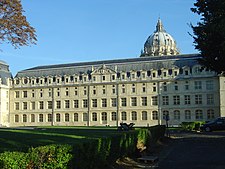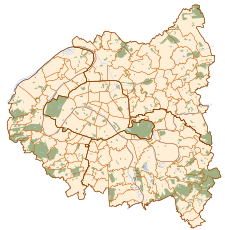Val-de-Grâce
| HIA Val-de-Grâce | |
|---|---|
| French Defence Health service | |
 |
|

The Old Buildings of Val-de-Grâce
|
|
|
Val-de-Grâce shown within the petite couronne
|
|
| Geography | |
| Location | 74 boulevard de Port-Royal, Paris 5e, Île-de-France, France |
| Coordinates | 48°50′21″N 2°20′40″E / 48.83917°N 2.34444°ECoordinates: 48°50′21″N 2°20′40″E / 48.83917°N 2.34444°E |
| Organisation | |
| Hospital type | Teaching |
| Services | |
| Beds | 350 |
| History | |
| Founded | 30 floréal an IV (19 May 1796) |
| Links | |
| Website | www |
The Val-de-Grâce (Hôpital d'instruction des armées du Val-de-Grâce or HIA Val-de-Grâce) is a military hospital located at 74 boulevard de Port-Royal in the 5th arrondissement of Paris, France.
The church of the Val-de-Grâce was built by order of Queen Anne of Austria, wife of Louis XIII. After the birth of her son Louis XIV, Anne (previously childless after 23 years of marriage) showed her gratitude to the Virgin Mary by building a church on the land of a Benedictine convent. Louis XIV himself is said to have laid the cornerstone for the Val-de-Grâce in a ceremony that took place April 1, 1645, when he was seven years old.
The church of the Val-de-Grâce, designed by François Mansart and Jacques Lemercier, is considered by some as Paris's best example of baroque architecture (curving lines, elaborate ornamentation, and harmony of different elements). Construction began in 1645, and was completed in 1667.
The Benedictine nuns provided medical care for injured revolutionaries during the French Revolution, and thus the church at Val-de-Grâce was spared much of the desecration and vandalism that plagued other, more famous Paris churches (for example, Notre-Dame was looted and turned into a warehouse, and Saint-Eustache was used as a barn). As a result, the church's exquisite interior is one of the few unspoiled remnants of Paris's pre-Revolution grandeur. Following the Revolution, the buildings were converted into a military hospital.
...
Wikipedia

